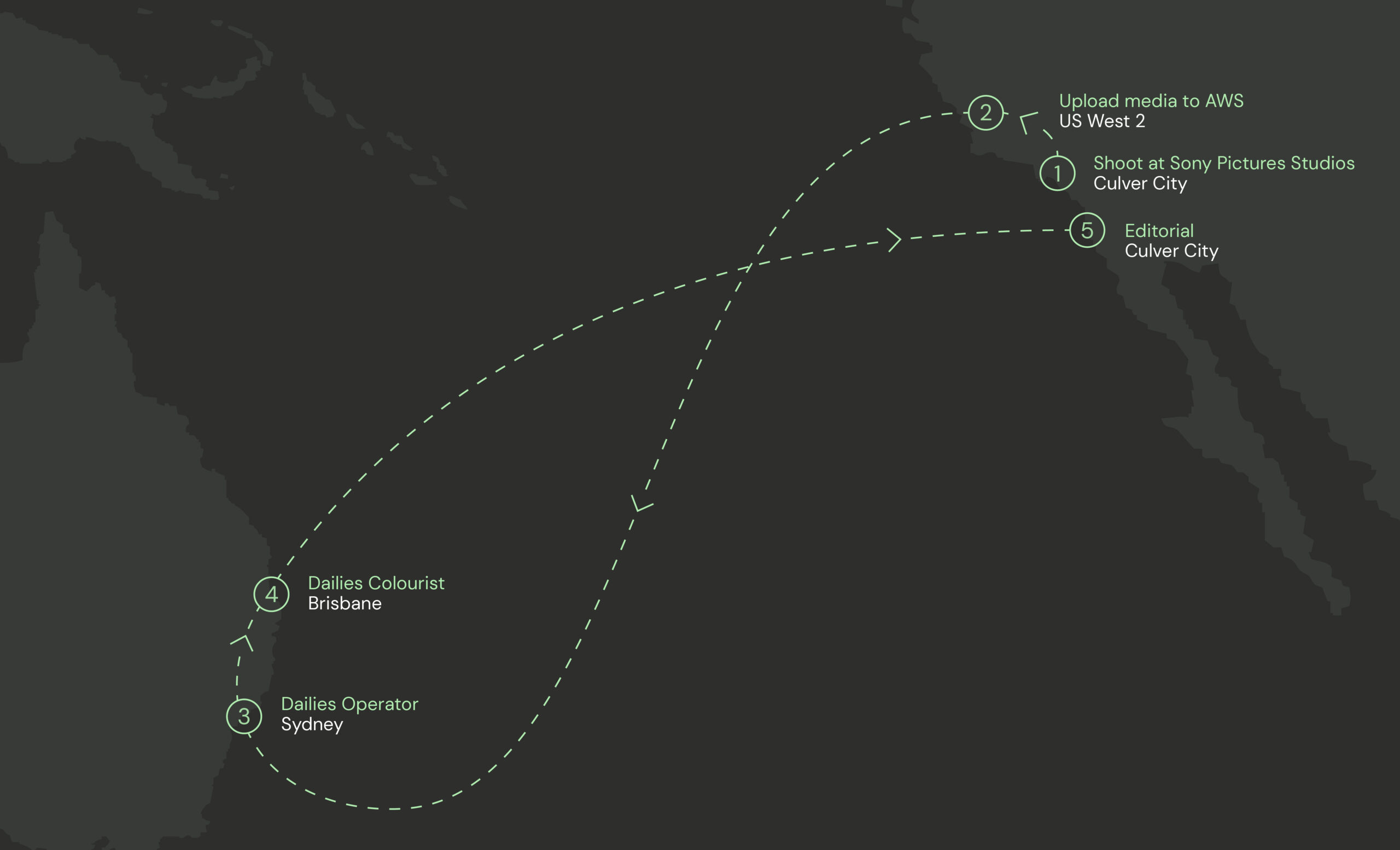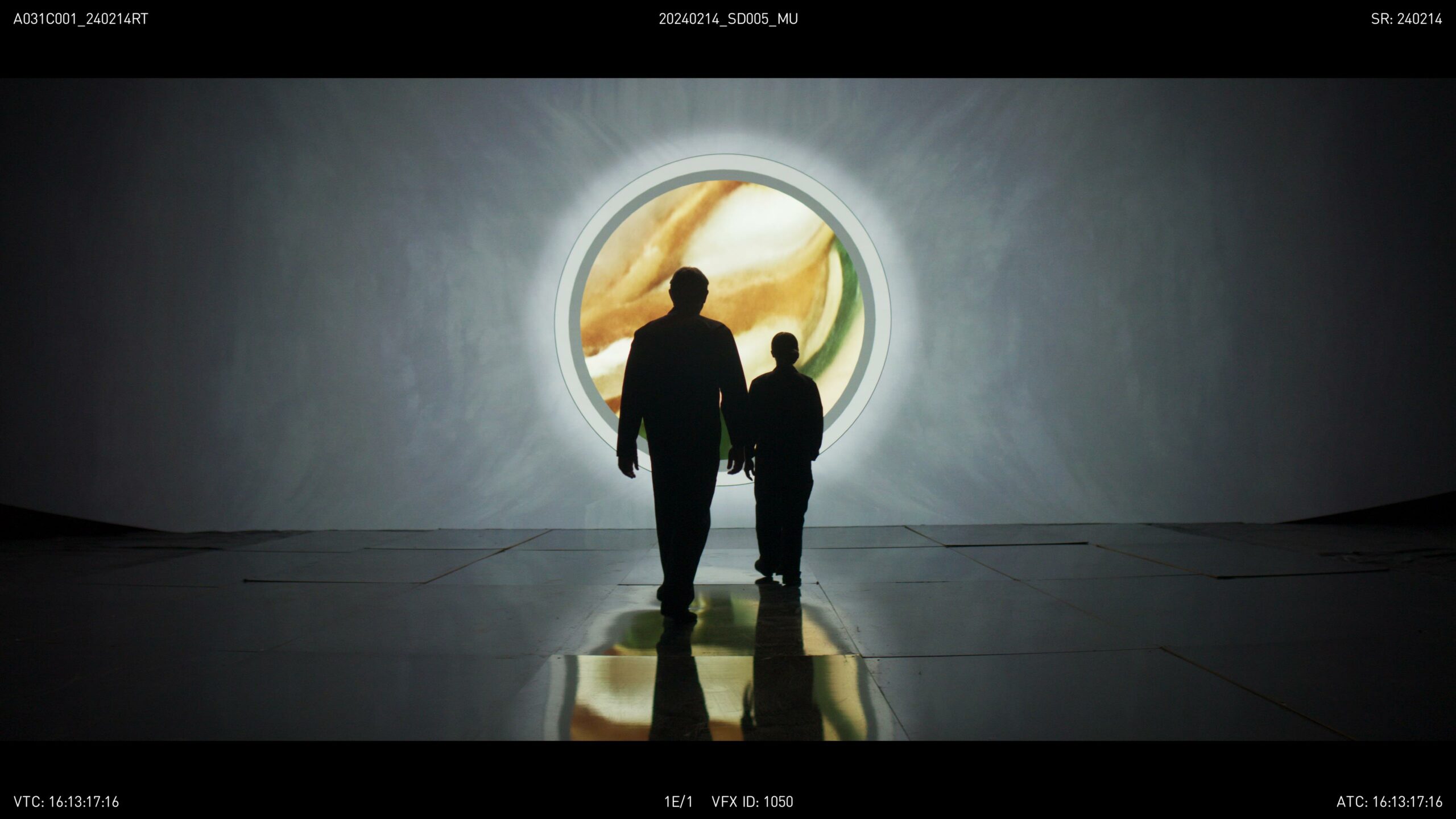The Challenge

The production was able to leverage a suite of tools available in the cloud using AWS. The media from the camera and the sound recordist was uploaded directly from the shoot Sony’s Stage 7 in Culver City to AWS, US West Coast 2. Once uploaded, TRFs team in Australia were able to access the bucket via Colorfront OSD running in EC2. OSD then reads the media directly from the bucket, and as soon as the transfer from the shooting location to the Cloud has completed, it’s ready for Dailies.
TRFs Dailies operator, Jamyka Blattman, was able to operate OSD from The Rebel Fleet’s Sydney office as if the media and software were running locally. Konsol was also running in AWS and accessing metadata from the same S3 bucket. Jamyka was able to load the metadata into the application, enabling the information to auto-link with the camera assets.
Then, once the media was prepped, the Dailies Colourist Warren Eagles was set to work from his at-home suite in Brisbane, Australia.
An outline of the Dailies workflow below:
- DIT onset in Culver City uploads Camera and sound files and metadata directly to AWS.
- All media and metadata is stored in one bucket.
- The Dailies operator, prepares media in Colorfront OSD and consolidates metadata using Konsol.
- The Dailies Colourist also running OSD is able to stream colour accurate pictures into their suite in Brisbane.
- Editorial receives collated and organised metadata from Konsol. Editorial media is outputted from Dailies back into the AWS market.

The Outcome
A dispersed team running Cloud-enabled, cutting-edge technology might seem like a complex proposition, but everything ran is as if the media and processes were running on premises. For Dailies operator, Jamyka Blattman, it was her first time working on a completely Cloud-based system, she was impressed at how seamless the experience was. “It worked out really well. As did the whole follow-the-sun workflow, with us working in Australia and the shoot happening in LA. The team in Los Angeles would finish shooting for the day, the media was uploaded to the Cloud, and it was instantly available: no wait time to download it. “I was able to jump on it during my day time, and complete my work. So by the time the team in LA were awake the next morning, the Editorial media had been delivered, the media was verified in the cloud, and camera cards were cleared for formatting on-set. It was all really smooth.”
The Rebel Fleet’s CTO, Pete Harrow, describes how it worked.
“Once the media was graded, OSD transcoded the media directly back to the bucket. Meanwhile, in Konsol, the Dailies team output a custom set of metadata for editorial. Customisable outputs from Konsol made it easy to structure the metadata as per the editorial team’s needs, giving them only what they required without affecting the main Konsol database. The compiled metadata can then continue to be used throughout the rest of the post-production process in VFX pulls, by VFX artists, in the DI, as well as organised using the Movie Labs Ontology for Media Creation.”
Avid Media Composer also accessed the S3 bucket directly, so as soon as the editorial media and Avid bin had been created the editorial team were able to work directly from the bucket.
“That was an amazing experience,” says Jamyka. “Usually I’m opening Avid on my machine, creating the bins, making sure it all lines up, then sending off those files. Then the editorial team has to download it at the media and bins. Whereas, because we were working on the same system in the Cloud, I had access to their Avid project. There was already a bin in Avid and I could just add the next day’s footage to their project.”
For Tom Thudiyanplackal, Europa’s Executive Producer, the implementation of cutting-edge technology was kind of the point.
“So the idea behind the Entertainment Technology Center is to bring players who, on any given day might be in competition with each other, together. At ETC they become scholars, fellow enthusiasts, who come to uncover what the future of filmmaking is going to be, and the products involved. But those products need to be battle-tested so that the industry can take them on and there’s an adoption cycle.”
Pursuing short film projects like Europa then becomes a perfect, proving ground. And while ETC had plenty of experience running such projects in the Cloud, Europa was the seventh film funded by a grant to use real-time pipelines, it would be a true testing ground for the capture and use of metadata, and for the running of a 24-hour work cycle, across time zones.
“One of the major things that came out, was the advantage of being in America and having our partners in New Zealand and Australia deliver pretty much a 24-hour turnaround,” says Tom. “Where we come in the next day and start seeing a very thorough package of all the camera metadata, all of the Dailies and everything starting to line up in a way that makes sense for each department.”
Konsol really proved its worth too, including how to structure the use of metadata.
“We went with a catch-all method, because we were doing it for the first time,” says Tom. “But I think with a big studio film I’d work backward and say, what kind of film are we making, what kind of partners are we going to work with, and isolate what makes the most sense for the pipeline.” Importantly, not only did Konsol offer more than enough capability for Tom’s project, in his eyes it showed its necessity for current and future filmmaking methodologies.
“Things are moving so quickly, now content is produced in a way where all the source material has to be saved because it will get worked on again at some stage. And usually very very quickly. The only way a new, unfamiliar team coming in will do it any justice is to have full access to the metadata.”
And for Tom, that’s where Konsol really showed its potential.
“As a central repository, where everything is married to the content so you get it when you touch it. That’s where it’s very well thought out, very streamlined and intuitive.”
